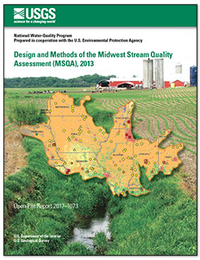Design and methods of the Midwest Stream Quality Assessment (MSQA), 2013
Links
- Document: Report (19.5 MB)
- Appendixes:
- Appendix 1 (149 KB xlsx) - Additional Site, Reach, and Watershed Characteristics of Selected Sites Assessed as Part of the U.S. Geological Survey (USGS) National Water-Quality Assessment (NAWQA) Midwest Stream Quality Assessment (MSQA) in 2013
- Appendix 2 (80.6 KB xlsx) - Description of the Laboratory Analyses Used for Water, Periphyton, Sediment, Fish Tissue, and Passive Integrated Samples
- Appendix 3 (50.5 KB xlsx) - Description of Quality Control Samples
- Appendix 4 (27.5 KB xlsx) - Description of the Sampling Timelines, Matrix, Collection, and Processing for Water, Sediment, and Ecological Samples
- Download citation as: RIS | Dublin Core
Abstract
During 2013, the U.S. Geological Survey (USGS) National Water-Quality Assessment Project (NAWQA), in collaboration with the USGS Columbia Environmental Research Center, the U.S. Environmental Protection Agency (EPA) National Rivers and Streams Assessment (NRSA), and the EPA Office of Pesticide Programs assessed stream quality across the Midwestern United States. This Midwest Stream Quality Assessment (MSQA) simultaneously characterized watershed and stream-reach water-quality stressors along with instream biological conditions, to better understand regional stressor-effects relations. The MSQA design focused on effects from the widespread agriculture in the region and urban development because of their importance as ecological stressors of particular concern to Midwest region resource managers.
A combined random stratified selection and a targeted selection based on land-use data were used to identify and select sites representing gradients in agricultural intensity across the region. During a 14-week period from May through August 2013, 100 sites were selected and sampled 12 times for contaminants, nutrients, and sediment. This 14-week water-quality “index” period culminated with an ecological survey of habitat, periphyton, benthic macroinvertebrates, and fish at all sites. Sediment was collected during the ecological survey for analysis of sediment chemistry and toxicity testing. Of the 100 sites, 50 were selected for the MSQA random stratified group from 154 NRSA sites planned for the region, and the other 50 MSQA sites were selected as targeted sites to more evenly cover agricultural and urban stressor gradients in the study area. Of the 50 targeted sites, 12 were in urbanized watersheds and 21 represented “good” biological conditions or “least disturbed” conditions. The remaining 17 targeted sites were selected to improve coverage of the agricultural intensity gradient or because of historical data collection to provide temporal context for the study.
This report provides a detailed description of the MSQA study components, including surveys of ecological conditions, routine water sampling, deployment of passive polar organic compound integrative samplers, and stream sediment sampling at all sites. Component studies that were completed to provide finer scale temporal data or more extensive analysis at selected sites, included continuous water-quality monitoring, daily pesticide sampling, laboratory and in-stream water toxicity testing efforts, and deployment of passive suspended-sediment samplers.
Suggested Citation
Garrett, J.D., Frey, J.W., Van Metre, P.C., Journey, C.A., Nakagaki, Naomi, Button, D.T., and Howell, L.H., 2017, Design and methods of the Midwest Stream Quality Assessment (MSQA), 2013: U.S. Geological Survey Open-File Report 2017–1073, 59 p., 4 app., https://doi.org/10.3133/ofr20171073.
ISSN: 2331-1258 (online)
Study Area
Table of Contents
- Acknowledgments
- Abstract
- Introduction
- Design of the Midwest Stream Quality Assessment Study
- Data Collection and Processing
- Laboratory Analyses
- Quality Assurance and Quality Control
- Special Studies
- References Cited
- Appendix 1. Additional Site, Reach, and Watershed Characteristics of Selected Sites Assessed as Part of the U.S. Geological Survey (USGS) National Water-Quality Assessment (NAWQA) Midwest Stream Quality Assessment (MSQA) in 2013
- Appendix 2. Description of the Laboratory Analyses Used for Water, Periphyton, Sediment, Fish Tissue, and Passive Integrated Samples
- Appendix 3. Description of Quality Control Samples
- Appendix 4. Description of the Sampling Timelines, Matrix, Collection, and Processing for Water, Sediment, and Ecological Samples
| Publication type | Report |
|---|---|
| Publication Subtype | USGS Numbered Series |
| Title | Design and methods of the Midwest Stream Quality Assessment (MSQA), 2013 |
| Series title | Open-File Report |
| Series number | 2017-1073 |
| DOI | 10.3133/ofr20171073 |
| Publication Date | October 18, 2017 |
| Year Published | 2017 |
| Language | English |
| Publisher | U.S. Geological Survey |
| Publisher location | Reston, VA |
| Contributing office(s) | National Water Quality Assessment Program |
| Description | Report: x, 57 p.; 4 Appendixes |
| Country | United States |
| State | Illinois, Indiana, Iowa, Kansas, Kentucky, Michigan, Minnesota, Missouri, Nebraska, Ohio, South Dakota, Wisconsin |
| Online Only (Y/N) | Y |
| Additional Online Files (Y/N) | Y |


